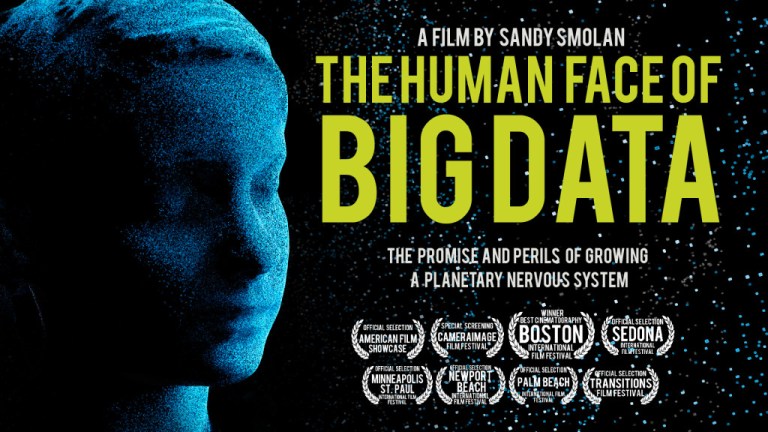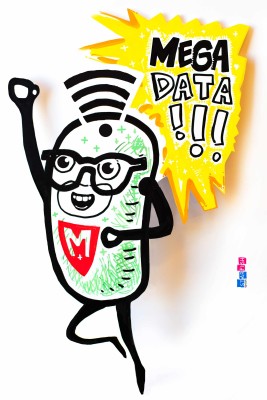We were recently tasked with facilitating and designing a workshop around the topic of Digital Transformation. What will the digital, hyper-interconnected world look like in the coming years? How will we benefit from all the information that is being captured and recorded? What are the key first steps we need to be taking now — and in which direction?
Beyond computing power and devices built to capture and measure, the underlying commodity is Big Data. One source for understanding what Big Data is, exactly, comes from the book entitled The Human Face of Big Data, by Rick Smolan and Jennifer Erwitt. In the book they use images, illustrations, and stories to talk about the impact of big data on people and everyday life.
The Human Face of Big Data is already a classic and a great introduction to how Big Data is changing the world. As with anything that ties the current state to the future, it will be interesting to see how it weathers time and where predictions and assumptions are correct. However, the book itself is an enormous, coffee table book weighing a couple of pounds, so it isn’t exactly a travel book!

But while designing the workshop and the icebreaker, we saw an opportunity to bring Big Data into the discussion early. The book itself was impractical; we know from experience in how little “pre-work” participants are willing to engage, and grabbing a copy of the book physically or on the Internet would be asking too much. Yet we wanted to share the story and we caught a break, it’s a movie too!
Normally we like to step into an icebreaker within the first 15 minutes of a workshop, and that really is a good rule to live by. However, sometimes you just ‘gotta’ break the rules and we found ourselves championing a great idea – let’s start with the intriguing movie about Big Data, and then use an icebreaker as a lever to find favorite messages and takeaways from the movie. It would be both educational and reflective, and it would help paint a picture of how Big Data was viewed by the participants. In addition, by kicking off with the 1-hour movie, we would realize the added benefits of a) not slowing any momentum gained during the workshop, and b) finding the fine line between sharing information that was critically needed, yet doing so in an engaging, non-interruptive way. So that’s what we did. We said hello, ran through a few key safety messages, killed the lights and let it roll! The movie is definitely worth watching if you get a chance. It has a nice balance of information, jaw-dropping stats, and a bit of humor. We’d recommend a little notebook or pad of Post-it notes because it’s the kind of movie where you will get ideas or want to go back to a certain topic for more information! The participants very much enjoyed the film.
The Icebreaker
So on to the icebreaker! Remember the key elements of a great icebreaker exercise: make it fun, make it personal, and make it relevant, with an added bonus for making it simple and straightforward. So we asked the participants simply what were your Top 3 takeaways from the movie? In a little more detail, we (as facilitators) asked the participants to:
1. Find a person in the room that you don’t know very well and introduce yourself.
2. Take a few minutes together to discuss the movie. Some suggested topics:
1. What did you like most about it?
2. Did you have a favorite scene/topic?
3. What was your biggest takeaway from the movie?
4. What will be the biggest impact of Big Data on you in the future?
3. Discuss any or all of those topics, but in 10 minutes you will need to have prepared a single Top 3 list on a flipchart to share with the others. There are no rules except the Top 3 must relate to the movie or Big Data in some way.
4. You will be given 3 minutes as a team to introduce yourselves (name, company, role) and share your Top 3 list to the entire group. Good luck!Overall objective: the compilation of the Top 3 lists from the other teams will help us distill, as a group, the most important takeaways from the movie.
As with any good icebreaker, the questions are open enough to allow the 2 (or 3 or 4) strangers in a group to have an easy path for meaningful conversation. They act primarily as a guide and allow participants to share personal experiences in relation to the movie, to inject as much humor into the Top 3 as they’d like, and keeps the focus on the Digital Transformation and Big Data topics that are the fabric of the workshop. In addition, while some groups find it difficult to stop at a Top 3, this lever can help you time box the introductions and icebreaker report backs. It is important to keep in mind that while an icebreaker can be fun and relevant, it’s still the starting point for your workshop and you probably want to speed it along as much as possible.
There are always variations you could use. One is to instruct the participants to use only drawings and illustrations for their report back. No WORDS allowed! It’s an easy way to encourage participants to begin the process of using illustrations to share their ideas during the workshop, quite an effective method to share big or complex ideas quickly. Plus, asking people to draw rather than write opens up the use of Visual Thinking and we almost always find a few people who can actually really draw!! A second variation could be defining one Post-it note per “Top Item” and using a grouping system when reporting back that will allow you to see a “tag cloud” of the takeaways from the group.
What the Icebreaker Achieved
By this time we’ve had a few laughs and introduced ourselves to the rest of the group. In fact, we’ve achieved several key points in relation to the participants and the workshop as a whole:
- People know each other, and everyone has spoken to the group.
- We’ve begun the all-important process of building trust in the group as teams learn to work in parallel.
- We have begun learning the process of hitting the high-points of a topic in a constrained time. This helps people
learn to quickly discard bad ideas and focus on moving toward a solution. To be honest, at this stage of a workshop
it’s less important that they find the Top 3 and more important that they go through the communication process of
building the list. - Later in the workshop, we will need people to debate about deeply important topics and reach a consensus and thisbegins that process. A gallery of the lists can be displayed to remind participants what was important enough to
become a Top 3, and allow others to quickly catch up if needed.
If you would like to see how this Icebreaker was used, head to Starfish Projects



